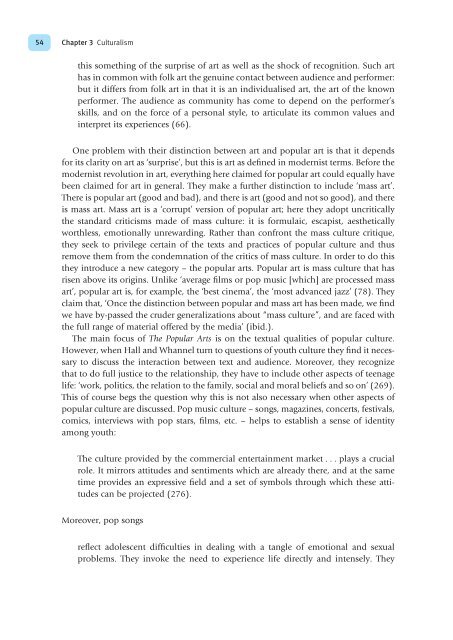Cultural Theory and Popular Culture
Cultural Theory and Popular Culture
Cultural Theory and Popular Culture
Create successful ePaper yourself
Turn your PDF publications into a flip-book with our unique Google optimized e-Paper software.
54<br />
Chapter 3 <strong>Cultural</strong>ism<br />
this something of the surprise of art as well as the shock of recognition. Such art<br />
has in common with folk art the genuine contact between audience <strong>and</strong> performer:<br />
but it differs from folk art in that it is an individualised art, the art of the known<br />
performer. The audience as community has come to depend on the performer’s<br />
skills, <strong>and</strong> on the force of a personal style, to articulate its common values <strong>and</strong><br />
interpret its experiences (66).<br />
One problem with their distinction between art <strong>and</strong> popular art is that it depends<br />
for its clarity on art as ‘surprise’, but this is art as defined in modernist terms. Before the<br />
modernist revolution in art, everything here claimed for popular art could equally have<br />
been claimed for art in general. They make a further distinction to include ‘mass art’.<br />
There is popular art (good <strong>and</strong> bad), <strong>and</strong> there is art (good <strong>and</strong> not so good), <strong>and</strong> there<br />
is mass art. Mass art is a ‘corrupt’ version of popular art; here they adopt uncritically<br />
the st<strong>and</strong>ard criticisms made of mass culture: it is formulaic, escapist, aesthetically<br />
worthless, emotionally unrewarding. Rather than confront the mass culture critique,<br />
they seek to privilege certain of the texts <strong>and</strong> practices of popular culture <strong>and</strong> thus<br />
remove them from the condemnation of the critics of mass culture. In order to do this<br />
they introduce a new category – the popular arts. <strong>Popular</strong> art is mass culture that has<br />
risen above its origins. Unlike ‘average films or pop music [which] are processed mass<br />
art’, popular art is, for example, the ‘best cinema’, the ‘most advanced jazz’ (78). They<br />
claim that, ‘Once the distinction between popular <strong>and</strong> mass art has been made, we find<br />
we have by-passed the cruder generalizations about “mass culture”, <strong>and</strong> are faced with<br />
the full range of material offered by the media’ (ibid.).<br />
The main focus of The <strong>Popular</strong> Arts is on the textual qualities of popular culture.<br />
However, when Hall <strong>and</strong> Whannel turn to questions of youth culture they find it necessary<br />
to discuss the interaction between text <strong>and</strong> audience. Moreover, they recognize<br />
that to do full justice to the relationship, they have to include other aspects of teenage<br />
life: ‘work, politics, the relation to the family, social <strong>and</strong> moral beliefs <strong>and</strong> so on’ (269).<br />
This of course begs the question why this is not also necessary when other aspects of<br />
popular culture are discussed. Pop music culture – songs, magazines, concerts, festivals,<br />
comics, interviews with pop stars, films, etc. – helps to establish a sense of identity<br />
among youth:<br />
The culture provided by the commercial entertainment market . . . plays a crucial<br />
role. It mirrors attitudes <strong>and</strong> sentiments which are already there, <strong>and</strong> at the same<br />
time provides an expressive field <strong>and</strong> a set of symbols through which these attitudes<br />
can be projected (276).<br />
Moreover, pop songs<br />
reflect adolescent difficulties in dealing with a tangle of emotional <strong>and</strong> sexual<br />
problems. They invoke the need to experience life directly <strong>and</strong> intensely. They
















